
As we’ve touched upon a couple of times in the past, while Jack Kirby’s innovation of turning the mythological figure of Thor into a super hero in the early days of the Marvel Age was undoubtedly a bit of inspiration on his part, it wasn’t a thing that happened in a vacuum. In fact, Thor was a well-known character of myth, and he and his enchanted hammer turned up several times in the comics well before JOURNEY INTO MYSTERY #83. Some of those earlier appearances came from Kirby’s hand as well–but a bunch of them did not. Today, we’ll look at another such appearance, the time that the Thunder God battled Batman and Robin.

The story appeared in BATMAN #127, published in 1959, three years before Marvel’s Thor debuted. So far as I can tell, this story has never been reprinted in the United States. It was written by Batman co-creator Bill Finger and illustrated by the primary Bob Kane ghost of this period, Sheldon Moldoff. Apart from drawing from teh same source material, this story doesn’t really have anything much in common with the later heroic Thor–but let’s take a look regardless.
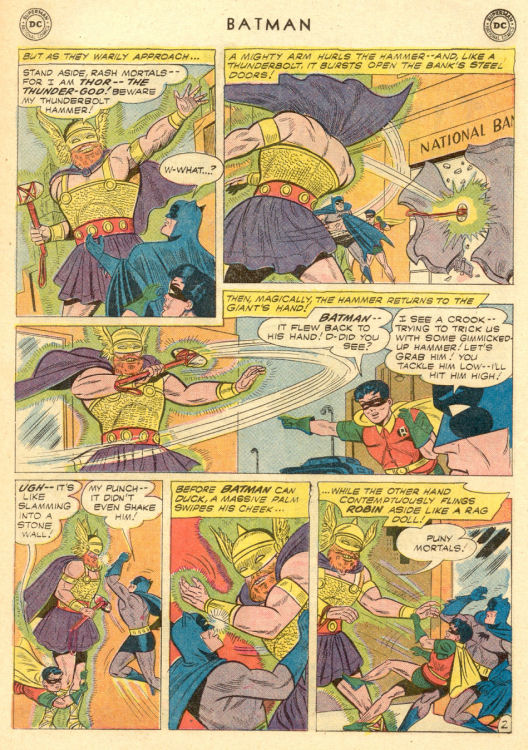
During the late 1950s when this story was published, Batman was in a bit of a doldrum. Having started out as a grounded and sinister sort of a series about an unarmed crime-fighter adopting a terrifying garb to aid in his war on the criminal element, but this point all of Batman’s sharp edges had been well worn down. He lived in a bright and shiny Gotham City, was a duly deputized officer of the law rather than a vigilante, and he spent an inordinate amount of time battling aliens and strange space creatures, as the thirst for science fiction material seemed to be what the buying public of kids wanted at this moment. Thor here wasn’t an alien, but he fit in perfectly among the other outlandish opponents that Batman and Robin regularly found themselves combating.
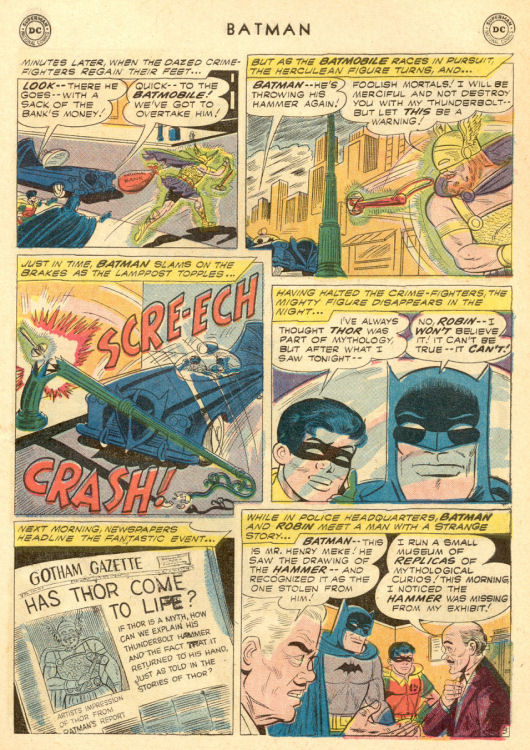
In this case, Thor is bookish Henry Meke, the curator of a museum of antiquities. As we learn as the story plays out, the hammer used by Thor was one of the exhibits on display. And when it was struck by an errant meteorite (!!!) it released radiations that caused Meke to be transformed into the mythological Thunder God whenever he was in the presence of a storm. But this Thor is unbalanced, robbing the riches of Gotham City so as to build a temple to Odin, king of the Gods.
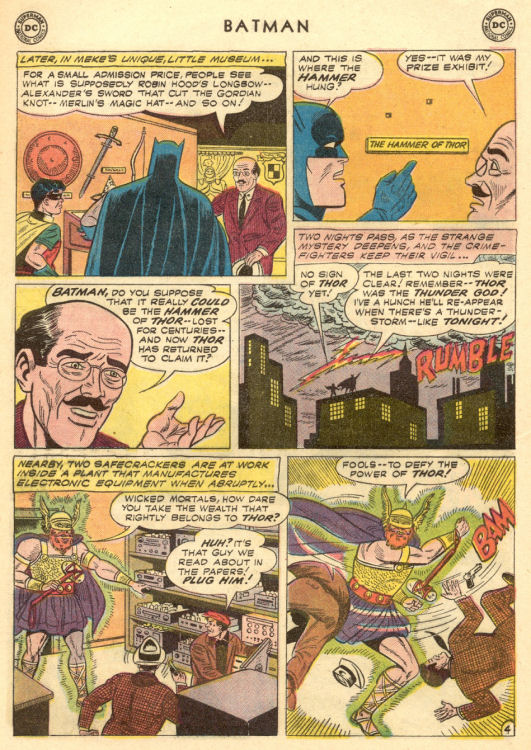
In the end, Batman is able to dissipate the charge of the hammer by jolting it with electricity, causing it to become inert again and the innocent Meke to be returned permanently to his human form.

It’s a totally forgettable adventure for the Caped Crusader, one that is only of note because of the later popularity of Marvel’s Thor. But one that does encapsulate the flavor of the Batman strip of this period, in which he was something of an unofficial police officer without any trace of the atmosphere that had once made him so popular (and would again in days to come.)
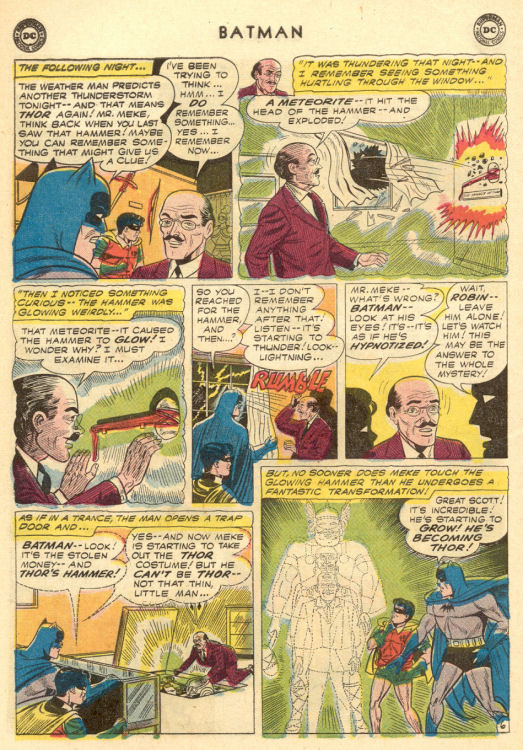
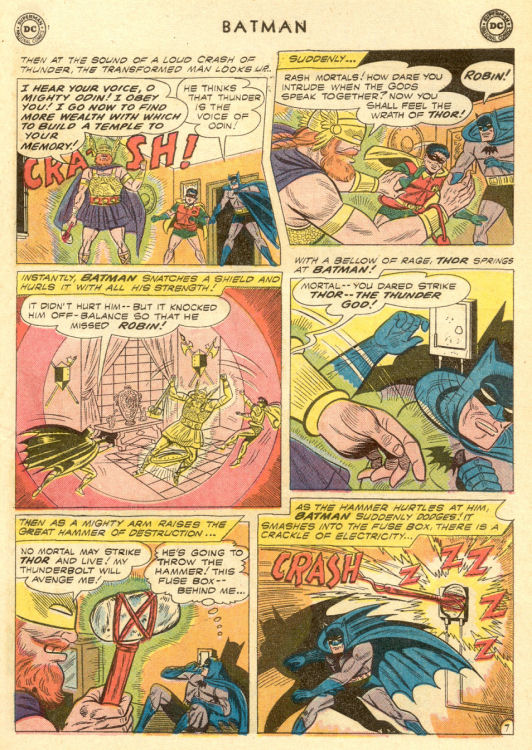
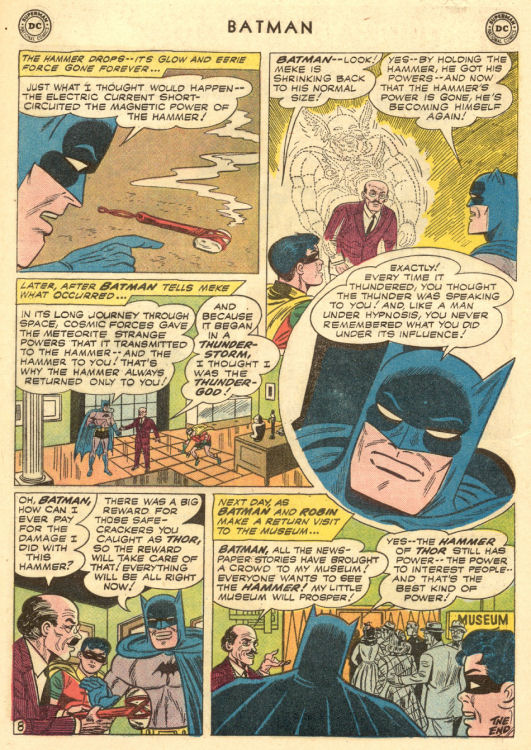

I imagine I’d have liked the art if I was a kid back then but reprints of Moldoff stories has had his art as the main barrier. I know Gil Kane and Joe Kubert’s art in the Golden Age looked nowhere near polished at did later so I was wondering if Moldoff did any later work that was more sophisticated looking.
LikeLiked by 1 person
The thing about Moldoff is, he’s doing an imitation of Kane’s style here, so a lot of what you likely don’t like about it is the Kane-isms. Look for his Golden Age Hawkman work and you’ll see Moldoff drawing like Moldoff.
LikeLiked by 4 people
And Moldoff was let go by DC in 1967, when they stopped with the Kane imitations. He didn’t do many more comics, but went into animation.
LikeLiked by 3 people
Never been a big winged character fan but you’re right. I just did some quick Googling and his Hawkman stuff from earlier is much better. I guess I never thought about him imitating another artist, especially one he was better than. I found an awesome Hawkman VS Poison Ivy pin up that’s even better.
LikeLiked by 2 people
And even stranger, is that when Carmine Infantino inaugurated the ‘new look’ Batman in 1964, Moldoff was doing Sheldon Moldoff doing Infantino as if he were Bob Kane.
Now that’s talent!
Bonus thought: If Dick Sprang (my favorite 50s Batman artist) didn’t retire from DC Comics in 1963, would he have adapted his style to fit the new approach?
LikeLiked by 5 people
And even Moldoff’s Hawkman art is pretty derivative of Alex Raymond. He was the Rich Buckler of his generation. 😉
I do have a great fondness for Moldoff’s Batman work, though — maybe because I saw so much of it reprinted in the ’70s at an impressionable age? There’s just something charmingly naïve about it. This era was a big influence on my “Lady Spectra & Sparky” webcomic.
In my headcannon, there’s a “lost scene” in JLA/Avengers where Thor turns to Batman and says, “Say, haven’t we met before…?”
LikeLiked by 3 people
Batman and Robin would encounter a different Thor in the past [ World’s Finest Comics#135 ( August 1963 ) ] who was a minor tribal chief with a magic hammer fashioned by him from a fiery star-stone that fell from the skies ( It returned to his hand after being thrown ). Future Man stole his hammer. There is a Thor in Superman’s Pal Jimmy Olsen too ( Haven’t seen what he looks like or what issue — I’ll have to look through comics.org ).
LikeLiked by 2 people
Superman’s Pal, Jimmy Olsen#16 (October 1956 ) first story: a Swami Rama ( “Con” Conners )shows Jimmy his past lives ( as Samson’s pal, Hercules’ pal & Thor’s pal ) with his reincarnation machine but it is a ruse to steal radium that is hidden at the Daily Planet. Samson, Hercules & Thor were all in Jimmy’s head created by hypnotic suggestion ( fake reincarnation machine’s helmet hypnotizing him ).
LikeLike
Golden Age company Fox had a THOR that had more in common with Eric Masterson’s Thor: “Thor, god of thunder, looks down upon the world from his lofty castle in Valhalla. He finds that there is need on Earth for his mighty powers.” He chooses Grant Farrel and teaches him how to use the power of Thor and of the hammer Mjolnir. Farrel uses his new powers to fight foreign spies and Germans. Farrel has a Clark Kent/Lois Lane relationship with Glenda, who scorns Farrel’s cowardice but yearns for Thor [ Weird Comics#1 ( April 1940 ) created by Pierce Rice and ? He has 2 appearances and Grant Farrel’s Thor is blond ]. I got this from Jess Nevins’ Encyclopedia of Golden Age Superheroes.
LikeLiked by 1 person
LikeLiked by 1 person
I guess a common similarity for most comics versions of Thor was the hammer returning to him after he threw it. Pretty useful feature. Must’ve been an app he downloaded. (How much memory was in those hammers? I guess there were upgrades w/ each version every few years…)
Couldn’t help but be reminded by this 1959 Thor’s golden “helmask” of Simonson’s similar model almost 30 years later. Though the wings on Walt’s remained “silver”. (I think “Walt’s Wings” may have been a fried chicken place in New Castle, DE.)
Tom mentioned Batman, “having started out as a grounded and sinister sort of a series about an unarmed crime-fighter”. Didn’t Tom read his article about “When Batman Carried a Gun”?! *Gasp!* ;-)
LikeLiked by 2 people
Perhaps a better phrase there would have been “pulp-style”. The key aspect isn’t using a gun or not, so much as being in a world of crime, thugs, corruption, and generally only slightly more than human-level powers.
Thor’s hammer returning to him when thrown was in the original Norse myths. Everybody uses it, because Thor throwing the hammer, and having it sit on the ground until he can go over and pick it up, would be really boring. Also, it seems to me that a non-magical warhammer wouldn’t make for a very accurate throwing weapon.
I don’t think there’s any connection, but this Thor is actually notably close to the original Marvel Thor in one aspect, in terms of being an ordinary human who is transformed by the hammer. And then transforms back to human from a “loss” of the hammer (here it being depowered itself). Again, that’s a common gimmick, but it’s an interesting parallel.
LikeLiked by 4 people
Thank you, Professor. I forgot a lot of those myths. Mix up Loki w/ Utgard Loki, & uptight Loki. Not the stuff I have reason to think about often. Yeah, I prefer my Batman in Gotham, w/ the occasional excursion out of town, while still being a terrestrial crimefighting detective. I like much of Jason Aaron’s writing, & some of Doug Mahnke’s drawing, but Batman Off-World, in space, etc., got a pass from me. Just not what interests me. The only writer I’d follow on something like that would be Grant Morrisson. Grant opened Batman’s “sci-fi closet” a few times, & it was fun. Grant’s stories very rarely fail to interest me.
LikeLike
I agree with the sentiment that Batman usually fought “grounded” menaces, even when they dressed up as playing cards and birds. But it’s worth pointing out that Bill Finger and the others on the strip knew they were writing for kids, so they were a little more playful with the rules of the game than the authors of BLACK MASK. I might not have remembered this on my own, but WORLD OF MONSTERS just ran a piece about a 1941 story in which B & R are transported into a book of fairytales, where they battle a witch, a dragon, and a couple of giants.
FWIW I have a memory of a tidbit about Moldoff I attribute to Michael Tiefenbacher’s COMIC READER. MT, as I recall, observed that one of the influences Kane swiped from in his earliest days was Chester Gould, if only in his jut-jawed heroes like Bats and Clip Carson. But when Moldoff tried to emulate that aspect of Gould-Moldoff, he rounded off the jaws so that a lot of characters resembled the Legion’s Bouncing Boy. Well, it amused me.
LikeLiked by 2 people
Two thoughts:
LikeLiked by 2 people
That was an interesting story. It good to see how the characters develop from the input of other creators. I still enjoy Jack Kirby’s, Marvel creation above all others. I doubt that will ever change. Nuff said! 😀
LikeLiked by 2 people
I don’t know, I think there’s something charming about Sheldon Moldoff’s artwork on stories such as this one. Yeah, I know, “charming” is a strange word to associate with a character like Batman in a modern-day context. But there’s just this fun sort of quality to the work both Moldoff and Dick Sprang did on the Batman stories of the late Golden Age and early Silver Age.
LikeLiked by 2 people
The first comic book I ever bought ..yeah..I’m an old fart..Tom sciacca
LikeLiked by 3 people
Ben H re: “charming”– I think the makers of BATMAN THE BRAVE AND THE BOLD may well agree with you. There’s some Golden and Bronze Age stuff referenced, but the show felt like a love letter, not just to Silver Age Batman, but to Schiff Age Batman. Lotta call-outs to Sprang. None I could see to Infantino or, even indirectly, to Schwartz, unless you wanna include non-Batman characters from FLASH et al.
LikeLiked by 2 people
Well. Man-Bat is a Schwartz-edited creation, as is Ra’s al-Ghul, and numerous other characters. Poison Ivy. Lucius Fox. Barbara Gordon. Leslie Thompkins. Zatanna. Rupert Thorne. Professor Milo. And others.
LikeLiked by 2 people
And by “Schiff Age Batman” I mean everything he did on the Bat-books after the Silver Age got trundling along.
LikeLike
Schiff had been editing Batman since the early 1940s. He had a nice period on pre-Code Batman (maybe 1950-’54 or so) that is well remembered by fans. I think the Science Fiction stuff Weisinger was doing with Binder on Superman made Donnerfield puish Schiff into taking the same route with Batman. (Schwartz also had success with Starngs Adventures, originally co-edited with Schiff, and MIS and the Flash looked promising.)
LikeLiked by 2 people
John Minehan said:
“Schiff had been editing Batman since the early 1940s”
Right, that’s why I added my qualifier. I was speaking only of what the producers of BTBATB *seemed* to indicate was their favorite Bat-period, not what fans in general liked. I also have the sense that fans barely knew anything about Schiff until he presided over post-Code Batman, which gave him more notoriety than fame in fan-circles. (He did get props in The Day for “Robin Dies At Dawn,” though.) Schiff became the goat turned out by fan-favorite Julie Schwartz, though I’ve not read that Schwartz’s Bat-books initially sold a lot better overall despite fan approbation. Then, Batmania changed everything– but that’s another story.
BTBATB did work in a lot of Golden Age villains, and even gave a tip of the sombrero to 1949’s “Bat-Hombre.” The writers just didn’t write scripts that were much like those of forties or early fifites Batman, though. A lot of what BTBATB featured was wild stuff like– well, Batman meeting Thor!
LikeLiked by 1 person
Kurt Busiek said:
“Well. Man-Bat is a Schwartz-edited creation, as is Ra’s al-Ghul, and numerous other characters. Poison Ivy. Lucius Fox. Barbara Gordon. Leslie Thompkins. Zatanna. Rupert Thorne. Professor Milo. And others.”
Right, Poison Ivy, Gordon and Zatanna are from the Schwartz Silver Age, but the writers don’t try to do anything like Schwartz stories, because they wanted a funnier Batman. Ditto the Bronze Age (beginning in 1970 in my book), except for Professor Milo, who hails from 1957, and thus from the Schiff Silver Age.
LikeLiked by 2 people